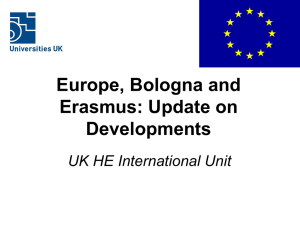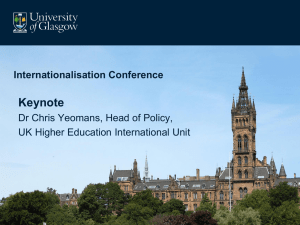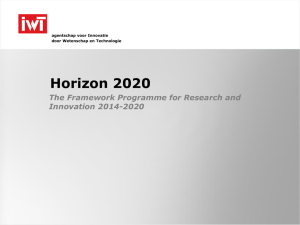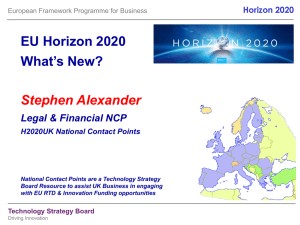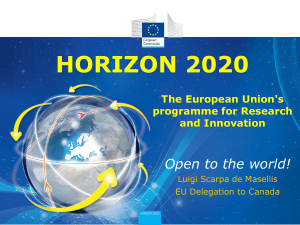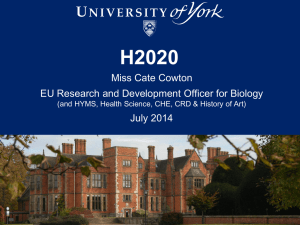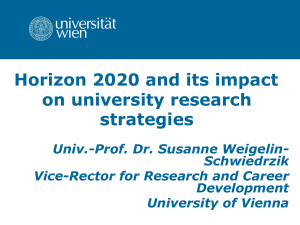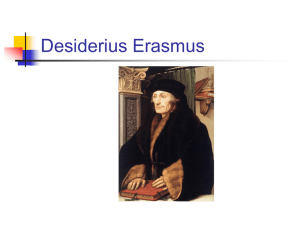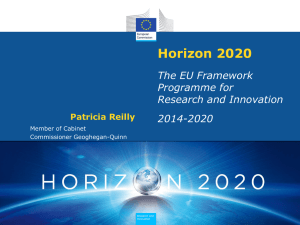Horizon 2020 - British Council
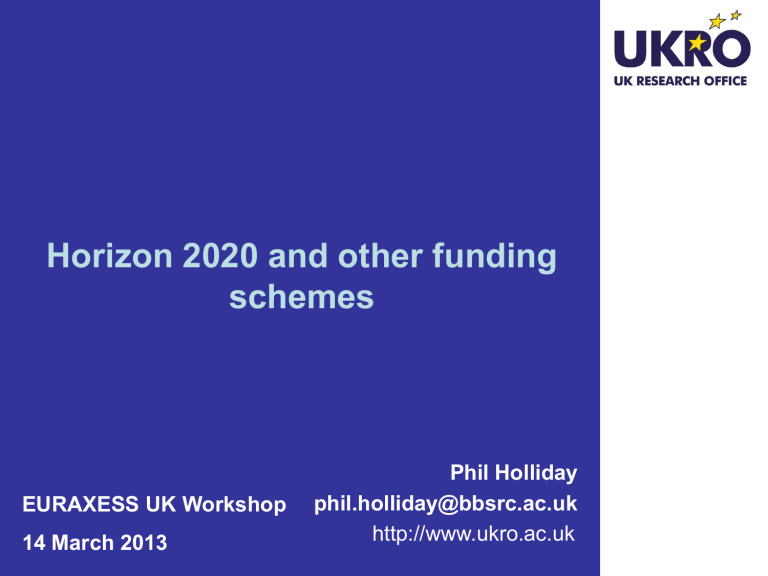
Horizon 2020 and other funding schemes
EURAXESS UK Workshop
14 March 2013
Phil Holliday phil.holliday@bbsrc.ac.uk
http://www.ukro.ac.uk
What is Horizon 2020
• A single programme bringing together three separate programmes/initiatives
• Framework Programme 7 (FP7)
• Competitiveness and Innovation Programme (CIP)
• European Institute of Innovation and Technology (EIT)
• Coupling research to innovation – from research to retail, all forms of innovation
• Focus on societal challenges facing EU society, e.g., health, clean energy and transport
• Simplified access, for all companies, universities, institutes in all EU countries and beyond
Excellent Science Base
• European Research Council (ERC)
• Future and Emerging Technologies (FET)
• Marie Skłodowska-Curie Actions
• Research Infrastructures
Industrial Leadership and Competitive Frameworks
• Leadership in enabling and industrial technologies:
ICT; Nanotechnologies; Advanced Materials; Biotechnology;
Advanced Manufacturing and Processing; and Space
• Access to risk finance
• Innovation in Small and Medium-Sized Enterprises (SMEs)
Tackling Societal Challenges
• Health, demographics changes and well being
• Food security, sustainable agriculture marine and maritime research and the bio-economy
• Secure, clean and efficient energy
• Smart, green and integrated transport
• Climate action and resource efficiency including raw materials
• Inclusive and innovative and secure societies
• Protecting freedom and security in Europe
European Institute of Innovation and Technology (EIT)
Joint Research Centre (JRC) Euratom (2014-2018)
Cross-cutting aspects
•
Aim to widen participation across whole programme to ensure excellence prevails wherever it exists
• Simplification as a crucial element
• More bottom-up elements to allow for novel ideas
•
Package of measures to close innovation divide
•
Links to Cohesion policy = building regional research & innovation capacity
• Boosting support to European Research Area (ERA) priorities – mobility, researcher careers, infrastructures, partnering, knowledge transfer, policy learning
•
Taking account of gender , ethical issues and open access to results
Horizon 2020
- Rules for Participation
• Single set of rules: for everyone (academia & industry)
• One Project – One Funding Rate
• Maximum of 100% of direct costs for all types of partners (except for actions close to market, where a 70% max)
• Indirect eligible costs: a flat rate of 20% of direct eligible costs
• No real indirect cost option
• Simple Evaluation Criteria : excellence, implementation, impact
• New Forms of funding for innovation : including dedicated SME funding instrument
• Improved rules on Intellectual Property : including new emphasis on Open Access
• Simplification : including no time-sheets for personnel working full time on a grant
• Fewer, more targeted controls and audits : audit strategy focused on risk and fraud prevention
International co-operation
• Instruments:
• Targeted actions on basis of common interest and mutual benefit
• Horizontal activities to promote strategy development of international cooperation (‘Inclusive, innovative & secure societies’)
• Who is likely to receive funding?
• Industrialised and emerging economies: x
• Enlargement and neighbourhood countries:
• Developing countries:
Positions of the Commission,
Parliament and Council
Commission
Position
€ 80 billion
Parliament Position Council Position
Six societal challenges
20% indirect costs rate
All close to market activities funded at
70%
€ 100 billion
Include “Spreading excellence and widening participation” in Pillar one
€ 71 billion (tbc)
Split societal challenge 6 into
“Innovative/Inclusive” part and “Security” part
Split societal challenge 6 into
“Innovative/Inclusive” part and “Security” part
Include real indirect costs option
25% indirect costs rate
Bonus capped at €8,000 per person per year
Universities in close to market activities funded at 100%
Next Steps for Horizon 2020
•
Trialogues on Horizon 2020 proposals
•
First trialogue met on 31 January
•
European Summit on 7-8 February
• MFF budget for 2014-2020 was agreed
• Horizon 2020 budget set at approx. €71 billion (tbc)
•
Second trialogue to meet on 5 March
•
Further trialogues (if required) will meet
• Final Horizon 2020 proposals published (by the end of 2013)
• Once Horizon 2020 legislation is approved bi-annual ‘Work Programmes’ containing calls will be published
•
Commission hopes to launch first Horizon 2020 calls in late 2013
Erasmus for All
Erasmus for All - overview
• Covers education at all levels, in a lifelong learning perspective, in particular:
• Higher Education
• Vocational Education and Training
• Adult Learning
• School education
• Youth
• Sport
• Replaces:
• Lifelong Learning Programme
• Youth in Action
• Erasmus Mundus
• ALFA III
• TEMPUS EDULINK
• bilateral co-operation with industrialised countries
• 75 activities in these programmes reduced to 11 under three broad headings
• Reduction of duplication and fragmentation
Proposed Erasmus for All
Structure
Key Action 1 – Learning Mobility of Individuals
• Staff mobility
• Student Mobility
• Erasmus Master
• Youth Mobility
Key Action 2 – Co-operation for innovation and
Good Practices
• Strategic Partnerships
• Knowledge alliances
• Sector Skills alliances
• Erasmus Youth Participation (non-formal learning)
Key Action 3 – Support for Policy Reform
Jean Monnet Initiative Sport
Positions of the Commission,
Parliament and Council
Commission Position Parliament Position
€ 19 billion
Erasmus for All
Streamline activities to focus on sectors
YES Europe
Continue to use existing brand names
(Erasmus, Grundtvig, etc)
Minimum budgetary thresholds:
83.4% for education and training;
8% for youth; and
1.8% for sport
Council Position
€ 12 billion (tbc)
Separate chapter and budget for youth
Minimum allocations for each different education and training sectors
Next Steps
• Irish Presidency priority to establish a common text from the Parliament and Council positions
• European Summit on 7-8 February
• MFF budget for 2014-2020 was agreed
• Erasmus for All budget set at approx. €12 billion (tbc)
• First informal trialogue between Council,
Parliament and Commission held on 19 February
• Subsequent trialogues to follow over the next few months
What is left in FP7?
The Final FP7 Calls
FP7-2013-ICT-FI (upcoming call)
•
Opens: 16 May 2013
•
Deadline: 10 December 2013
•
Indicative budget: EUR 130 million
•
Two topics under ICT Challenge 1
:
• Expansion of Use Case
• Technology Foundation Extension and Usage
• One stage evaluation
• Negotiations expected to start May 2014
FP7-ATT-2013-RTD-HIGH
SPEED
•
Opens: 10 July 2012
•
Deadline: 29 March 2013
•
Budget: EUR 5 million
• One project to be funded
• International co-operation on civil high speed air transport research
• The project will allow the gathering of critical mass and the means to perform flight testing for long term speed aircraft developments and will create durable links between the EU and the international partners
• Projects are funded as CP (Collaborative Projects)
Individual Fellowships: IEF, IIF,
IOF
Intra-European
(IEF)
Researchers based in the
EU or Associated Country
12
– 24 months in an EU
Member State or
Associated Country
Attaining or strengthening professional independence and skills diversification
International Outgoing
(IOF)
For EU Member State or
Associated Country nationals*
24
– 36 months with 12 –
24 months in third country followed by mandatory reintegration phase in
European host institution
International Incoming
(IIF)
Researchers based in third countries
12
– 24 months incoming phase in EU Member
State/Associated Country
Acquiring new knowledge in the third country
– bringing it back to the MS/AC
Mutually beneficial research co-operation and knowledge sharing
Can be resuming a career in research
Mandatory return phase of
1 year
Possible 1 year reintegration grant for nationals from ICPCs
(
€15,000)
* PLUS non-nationals in MS/AC for more than five years at deadline
Career Integration Grants (CIG)
What is an CIG?
Funding for those taking up stable post after a period of mobility, to provide them with their own research budget and to support their integration into research career in Europe.
Who is eligible?
•
For experienced researchers only.
• Applicant must comply with the mobility rule.
• No requirement to have benefited from a Marie Curie project previously.
What does a CIG fund?
• Supports a research project of 2 – 4 years
• €25,000 per year flat rate funding
• Contributes to the research costs
• Host commits to employ researcher for at least duration of project.
• Should enable transfer of knowledge and building of links with country from which researcher has moved

